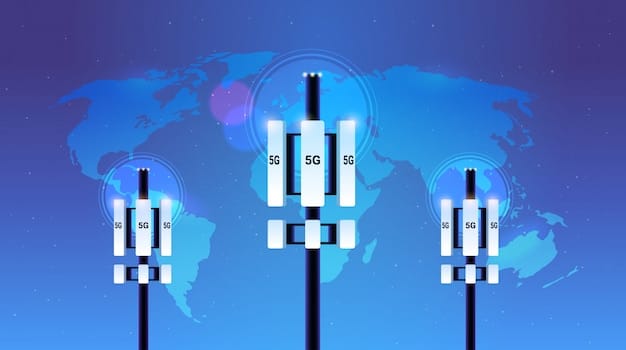Cord-Cutting Impact: Analysis of TV News Revenue Model Transformation

The rise of cord-cutting is significantly reshaping TV news revenue models, leading to a shift from traditional advertising and cable subscription fees to digital platforms, streaming services, and innovative content monetization strategies to maintain profitability and relevance.
The media landscape is undergoing a seismic shift, largely driven by the phenomenon of cord-cutting. This trend, where viewers abandon traditional cable subscriptions in favor of streaming services and digital content, is compelling TV news organizations to fundamentally rethink their revenue models. How are they adapting?
The Cord-Cutting Revolution: A Shifting Landscape
The decline of traditional cable subscriptions has been a long time coming but picked up pace in the last decade. TV news organizations, long accustomed to a steady stream of revenue from advertising and subscriber fees, now face a reality where their audience is increasingly fragmented across various digital platforms. This shift demands a strategic overhaul of how they generate income and engage viewers.
The Decline of Cable and the Rise of Streaming
The data is clear: cable subscriptions are plummeting. Services like Netflix, Hulu, and Amazon Prime Video have disrupted the entertainment industry, offering on-demand content at competitive prices. This has led many viewers to cut the cord, relying solely on these services for their viewing needs. How is TV news adapting, and what does this mean for revenue?
Impact on Traditional Advertising Revenue
For decades, TV news organizations relied heavily on advertising revenue. As viewership shifts to digital platforms, advertisers are following suit. This creates a challenge for TV news, which must now compete with digital-native platforms for advertising dollars. What new advertising approaches are emerging to tackle this shift?

Considering the above, here are some key aspects of this transformation:
- Digital Advertising Growth: TV news organizations are investing heavily in digital advertising, including pre-roll video ads, display ads, and sponsored content.
- Content Integration: Integrating ads more seamlessly into news content to improve engagement and reduce ad fatigue.
- Data-Driven Advertising: Leveraging data analytics to target ads more effectively and demonstrate value to advertisers.
In conclusion, the rise of cord-cutting necessitates that TV news organizations innovate and adapt to the digital landscape. This often means a shift from the traditional advertising to a mix of digital revenue streams. The path forward involves embracing new technologies, focusing on content quality, and understanding the changing viewing habits of their audience.
Diversifying Revenue Streams: Beyond Traditional Advertising
With traditional revenue streams dwindling, TV news organizations are exploring new and innovative means of generating income. This diversification is crucial for maintaining financial stability and continuing to provide high-quality journalism. It also means understanding how streaming and digital platforms function in order to capture a significant market share. Some may even consider venturing into subscription models.
Subscription Models for News Content
Some TV news organizations are experimenting with subscription models, offering exclusive content, behind-the-scenes access, and ad-free viewing experiences to paying subscribers. This approach can generate a predictable and recurring revenue stream. What are the pros and cons of this method, and which organizations can benefit the most?
Partnerships with Streaming Platforms
Many TV news outlets are partnering with streaming platforms to distribute their content to a wider audience. This can involve licensing news programming to services like Hulu, Roku, and Peacock, or creating original content specifically for these platforms. But how do these partnerships affect the brand and revenue of traditional news organizations?
Here are the main benefits for partnering with these streaming platforms:
- Expanded Reach: Access to millions of potential viewers who are already subscribed to these services.
- Additional Revenue: Licensing fees and revenue sharing agreements can provide a significant boost to the bottom line.
- Content Exposure: Increased visibility for news content and brand recognition.
The diversification of revenue streams is not just a survival tactic but an opportunity for TV news organizations to thrive in the digital age. By embracing these new approaches, news organizations can ensure they continue providing valuable journalism to the public.
The Rise of Digital-First News: Adapting to Online Audiences
The shift to digital has pushed a ‘digital-first’ approach. This involves producing content specifically for online platforms, optimizing it for mobile devices, and engaging with audiences on social media. Embracing digital-first strategies requires a cultural change within news organizations, with a focus on innovation and experimentation. It also requires that the editorial team be aware of which platforms are more popular in their target demographic.
Optimizing Content for Online Consumption
Online audiences have different viewing habits than traditional TV viewers. Content must be shorter, more engaging, and easily accessible on mobile devices. TV news organizations are experimenting with new formats, such as short video clips, interactive graphics, and social media stories. How can TV news ensure that the quality of their journalism isn’t affected by these new constraints?
Engaging with Audiences on Social Media
Social media platforms like Twitter, Facebook, and Instagram have become essential tools for TV news organizations to reach and engage with their audience. This involves sharing news updates, hosting live Q&A sessions, and encouraging user-generated content. How can TV news organizations use social media to build trust and credibility?

Here are some strategies that are emerging in this new market:
- Live Streaming: Broadcasting news events and interviews live on social media platforms like Facebook Live and YouTube Live.
- Interactive Content: Creating polls, quizzes, and other interactive content to engage with audiences and gather feedback.
- Personalized Content: Utilizing data analytics to deliver personalized news content to individual users based on their interests and preferences.
The shift to digital-first news is not just about adapting to new platforms, but about fundamentally rethinking how news is produced, distributed, and consumed. TV news organizations that embrace this approach will be best positioned to thrive in the evolving media landscape.
Data Analytics and Audience Engagement: Understanding Viewer Behavior
In the digital age, data is king. TV news organizations are increasingly relying on data analytics to understand viewer behavior, measure the effectiveness of their content, and tailor their programming to meet the needs of their audience. This data-driven approach is essential for maximizing revenue and maintaining relevance in a competitive market. But data is only as useful as the insights gained from it; how are news organizations putting this data to work?
Tracking Viewer Engagement Metrics
TV news organizations are tracking a variety of metrics to gauge viewer engagement, including viewership numbers, time spent watching, click-through rates, and social media shares. This data provides valuable insights into what content resonates with viewers and what content falls flat. Therefore, understanding the viewing behavior of the audience is essential.
Using Data to Personalize Content
Data analytics can also be used to personalize content, delivering news and information that is relevant to individual viewers based on their interests, location, and demographics. This can increase viewer engagement and loyalty. What are the ethical considerations here, and how can TV news avoid being seen as manipulative?
Here are several ways how TV news organizations are adapting to the market regarding viewers metrics:
- Content Recommendations: Suggesting news stories and videos to viewers based on their past viewing habits.
- Personalized Newsletters: Sending out email newsletters with news content tailored to individual interests.
- Targeted Advertising: Delivering ads that are relevant to individual viewers based on their demographics and browsing history.
By leveraging data analytics, TV news organizations can gain a deeper understanding of their audience and tailor their content and programming to meet their needs. This will helps to increase viewer engagement, improve retention rates, and drive revenue growth.
The Future of Local News: Community Engagement and Hyperlocal Content
While national news remains important, local news plays a crucial role in informing communities and holding local governments accountable. The rise of cord-cutting and digital media has created both challenges and opportunities for local news organizations. Many TV stations are shifting their focus away from national headlines and more toward local coverage. How is this affecting the news that reaches viewers?
Building Relationships with Local Communities
Local news organizations are focusing on building stronger relationships with their communities, attending local events, partnering with local businesses, and highlighting local issues. This can increase viewer loyalty and support. What are the key differences between reporting on local issues versus national or global news?
Producing Hyperlocal Content
Hyperlocal content, which focuses on very specific geographic areas or communities, is becoming increasingly popular. This can include news about local schools, crime rates, and community events. TV-stations may need to hire freelance reporters to broaden the market and increase hyperlocal coverage.
There are clear benefits to having localized TV news such as:
- Community Support: Increased loyalty and support from local viewers who value local news coverage.
- Unique Content: The ability to provide news content that is not available from national news organizations.
- Advertising Revenue: Attracting local advertisers who want to reach a specific geographic audience.
The key to success for local news organizations is to adapt to the changing media landscape while staying true to their mission of informing and serving their communities. This involves embracing new technologies, building strong relationships with local residents, and focusing on hyperlocal content that is relevant and engaging.
Talent and Technology: Investing in the Future of News Delivery
The TV news industry is undergoing a technological revolution, but the human element remains critical. Investing in both talent and technology is essential for TV news organizations to stay competitive. This includes hiring skilled journalists, data analysts, and digital marketers, as well as investing in new equipment, software, and infrastructure. It involves using that technology to better deliver content.
Attracting and Retaining Top Talent
Attracting and retaining top talent is a challenge for TV news organizations, particularly in the face of competition from digital media companies. This requires offering competitive salaries, providing opportunities for professional growth, and creating a positive and supportive work environment. What are the main skills and experiences that news organizations are looking for today?
Embracing New Technologies for News Gathering and Delivery
TV news organizations are embracing new technologies for news gathering and delivery, including drones, virtual reality, and artificial intelligence. These technologies can improve the efficiency and effectiveness of news operations. For example, drones can cover high-speed chases from the air, and virtual reality can immerse viewers in a news story.
There many benefits to investing in top talent along with the latest technology:
- Improved Content Quality: Skilled journalists and data analysts can produce higher-quality news content that engages viewers.
- Increased Efficiency: New technologies can streamline news gathering and delivery, reducing costs and improving efficiency.
- Competitive Advantage: Investing in talent and technology can provide a competitive advantage in a dynamic market.
In conclusion, by investing in both talent and technology, TV news organizations can improve their content quality, increase their efficiency, and gain a competitive advantage in the rapidly evolving media landscape. This dual focus is essential for ensuring the future success of TV news.
| Key Point | Brief Description |
|---|---|
| 📉 Cable Decline | Traditional cable subscriptions are rapidly declining. |
| 📱 Digital First | A shift is occurring to online content through smartphones. |
| 📊 Data Analytics | Data is essential to know the audience for personalized content. |
| 🏘️ Local News | Hyperlocal content is crucial for building engagements. |
Frequently Asked Questions
▼
Cord-cutting is reducing traditional advertising and cable fees for TV news, organizations are forced to explore digital platforms and subscriptions to maintain revenue.
▼
Subscription models, partnerships with streaming platforms, and digital advertising are among the new sources of revenue TV networks are seeking.
▼
Social media helps TV news organizations extend the viewership into online communities, as well as promote journalism to a broad demographic.
▼
Hyperlocal content provides news for specific geographic areas or communities such as schools, community events and local crime rates to increase views for that location.
▼
Data analytics is a main tool in understanding the audience allowing the team to personalized content to meet the needs of individual viewers.
Conclusion
The TV news landscape is in a state of flux. The factors discussed have significantly impacted traditional revenue models. This shift demands innovation, adaptability, and a deep understanding of evolving audience preferences. By embracing digital platforms, diversifying revenue streams, and investing in both talent and technology, TV news organizations can not only survive but thrive in this digital era, and continue to serve their communities with high-quality journalism.





